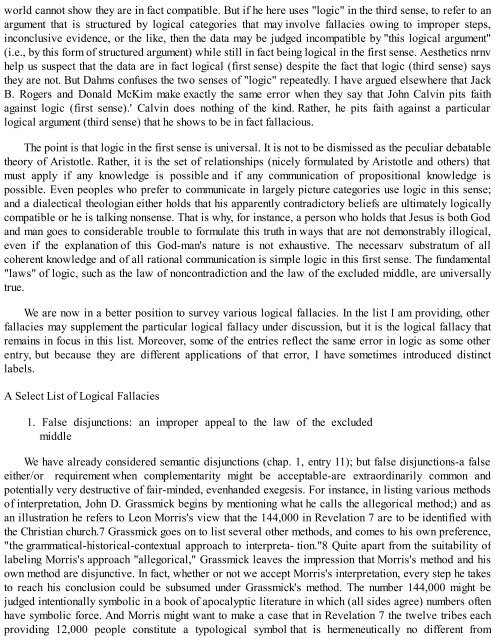Exegetical Fallacies - D. A. Carson
Exegetical Fallacies - D. A. Carson
Exegetical Fallacies - D. A. Carson
You also want an ePaper? Increase the reach of your titles
YUMPU automatically turns print PDFs into web optimized ePapers that Google loves.
world cannot show they are in fact compatible. But if he here uses "logic" in the third sense, to refer to an<br />
argument that is structured by logical categories that may involve fallacies owing to improper steps,<br />
inconclusive evidence, or the like, then the data may be judged incompatible by "this logical argument"<br />
(i.e., by this form of structured argument) while still in fact being logical in the first sense. Aesthetics nrnv<br />
help us suspect that the data are in fact logical (first sense) despite the fact that logic (third sense) says<br />
they are not. But Dahms confuses the two senses of "logic" repeatedly. I have argued elsewhere that Jack<br />
B. Rogers and Donald McKim make exactly the same error when they say that John Calvin pits faith<br />
against logic (first sense).' Calvin does nothing of the kind. Rather, he pits faith against a particular<br />
logical argument (third sense) that he shows to be in fact fallacious.<br />
The point is that logic in the first sense is universal. It is not to be dismissed as the peculiar debatable<br />
theory of Aristotle. Rather, it is the set of relationships (nicely formulated by Aristotle and others) that<br />
must apply if any knowledge is possible and if any communication of propositional knowledge is<br />
possible. Even peoples who prefer to communicate in largely picture categories use logic in this sense;<br />
and a dialectical theologian either holds that his apparently contradictory beliefs are ultimately logically<br />
compatible or he is talking nonsense. That is why, for instance, a person who holds that Jesus is both God<br />
and man goes to considerable trouble to formulate this truth in ways that are not demonstrably illogical,<br />
even if the explanation of this God-man's nature is not exhaustive. The necessarv substratum of all<br />
coherent knowledge and of all rational communication is simple logic in this first sense. The fundamental<br />
"laws" of logic, such as the law of noncontradiction and the law of the excluded middle, are universally<br />
true.<br />
We are now in a better position to survey various logical fallacies. In the list I am providing, other<br />
fallacies may supplement the particular logical fallacy under discussion, but it is the logical fallacy that<br />
remains in focus in this list. Moreover, some of the entries reflect the same error in logic as some other<br />
entry, but because they are different applications of that error, I have sometimes introduced distinct<br />
labels.<br />
A Select List of Logical <strong>Fallacies</strong><br />
1. False disjunctions: an improper appeal to the law of the excluded<br />
middle<br />
We have already considered semantic disjunctions (chap. 1, entry 11); but false disjunctions-a false<br />
either/or requirement when complementarity might be acceptable-are extraordinarily common and<br />
potentially very destructive of fair-minded, evenhanded exegesis. For instance, in listing various methods<br />
of interpretation, John D. Grassmick begins by mentioning what he calls the allegorical method;) and as<br />
an illustration he refers to Leon Morris's view that the 144,000 in Revelation 7 are to be identified with<br />
the Christian church.7 Grassmick goes on to list several other methods, and comes to his own preference,<br />
"the grammatical-historical-contextual approach to interpreta- tion."8 Quite apart from the suitability of<br />
labeling Morris's approach "allegorical," Grassmick leaves the impression that Morris's method and his<br />
own method are disjunctive. In fact, whether or not we accept Morris's interpretation, every step he takes<br />
to reach his conclusion could be subsumed under Grassmick's method. The number 144,000 might be<br />
judged intentionally symbolic in a book of apocalyptic literature in which (all sides agree) numbers often<br />
have symbolic force. And Morris might want to make a case that in Revelation 7 the twelve tribes each<br />
providing 12,000 people constitute a typological symbol that is hermeneutically no different from



